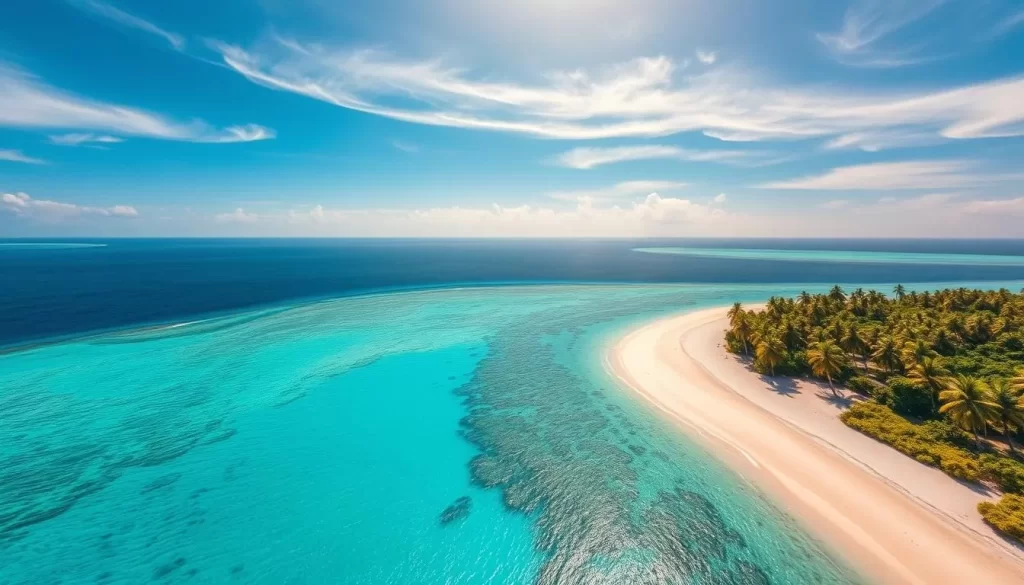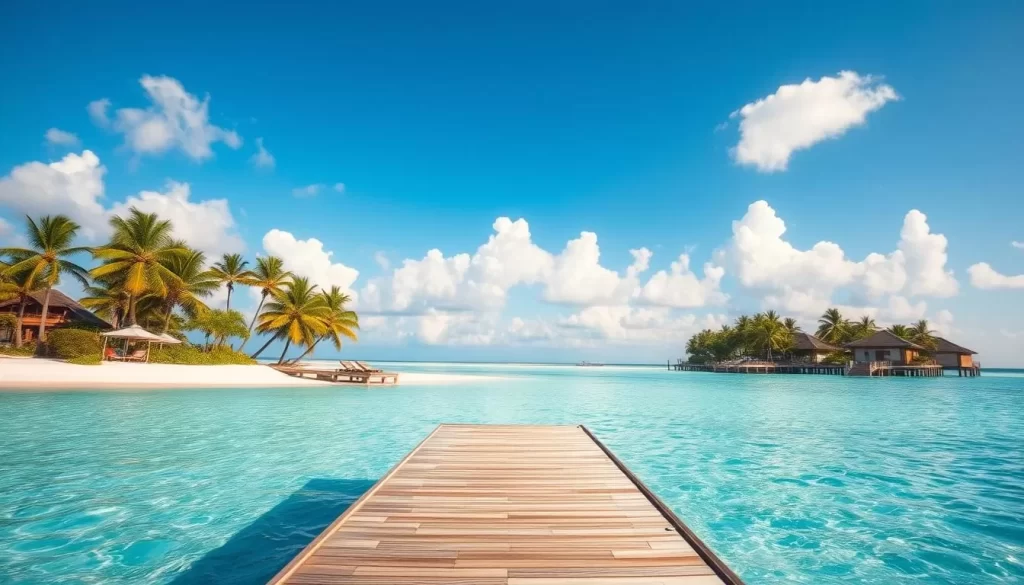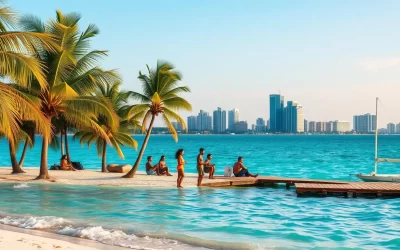✓ Accommodations ✓ Flights ✓ Rental Cars ✓ Tours & Activities
Are you planning a trip to the Maldives, known for its pristine islands and water temperatures that remain tropical throughout the year?
The climate in this Indian Ocean archipelago is characterized by two distinct seasons: dry and wet. Understanding these weather patterns is crucial for making the most of your trip, whether you’re interested in diving, snorkeling, or simply relaxing on the beach.
With average temperatures of 83 degrees Fahrenheit (28 degrees Celsius) throughout the year, the Maldives is a year-round destination. However, knowing the time to visit can significantly enhance your vacation experience.
This guide will help you navigate the seasonal variations to determine the ideal time for your visit based on your preferences for weather, activities, and budget.
Understanding Maldives Climate Patterns
As an archipelago stretching across 541 miles, the Maldives exhibits varied climate conditions. This geographical spread significantly influences the weather patterns across the islands.
The Two Main Seasons: Dry and Wet
The Maldives experiences two primary seasons: the dry season and the wet season. The dry season, characterized by low rainfall and calm seas, is generally considered the best time to visit. In contrast, the wet season brings heavy rainfall and rough seas, which might not be ideal for all travelers.
Regional Weather Variations: North vs South Atolls
The climate varies between the northern and southern atolls due to the Maldives’ extensive north-south stretch. The northern atolls typically experience the rainy season from May through November, while the southern atolls see more rainfall from November through March. Additionally, being closer to the equator, the southern atolls are generally hotter and more humid throughout the year.
| Atolls | Rainy Season | Weather Characteristics |
|---|---|---|
| Northern Atolls | May – November | Cooler, less humid |
| Southern Atolls | November – March | Hotter, more humid |

Understanding these regional variations can help you choose the best time and location for your trip, ensuring a more enjoyable experience.
Maldives: Best Months for a Weather-Savvy Trip
To make the most of your Maldives vacation, it’s crucial to consider the weather patterns and choose the right time to visit. The Maldives experiences two main seasons: the dry season and the monsoon season, each offering unique advantages and considerations.
November to April: The Dry Season Advantage
The dry season, from November to April, is characterized by calm seas, clear skies, and minimal rain. This period is ideal for water activities like diving and snorkeling due to the excellent visibility. The dry conditions make it perfect for beach activities and island hopping. With pleasant weather conditions, this is the peak tourist season, attracting visitors from around the world.
May to October: Monsoon Season Considerations
In contrast, the monsoon season from May to October brings increased rainfall, higher humidity, and a chance of storms. However, this period also offers significant advantages for budget-conscious travelers. You can expect substantial discounts on accommodations, with luxury resorts often reducing rates by 30-50% compared to peak season prices. Despite the rain, many days still feature plenty of sunshine, and the monthly rainfall can vary, making it a viable option for those looking for bargains.

Month-by-Month Weather Guide
To make the most of your Maldives vacation, it’s essential to know what the weather is like each month. The Maldives’ climate varies significantly throughout the year, impacting your travel plans and activities.
December to February: Peak Season Perfection
This period is considered the peak tourist season due to its dry and sunny weather. The temperatures are pleasant, making it ideal for outdoor activities like snorkeling and diving. With minimal rain, you can enjoy the beautiful beaches and crystal-clear waters without interruptions.
March to May: Transition Period
As the peak season ends, the Maldives enters a transition period. The weather starts to get warmer, and there’s a slight increase in humidity. Although it’s not as dry as the previous months, the time of year still offers plenty of sunshine, making it a good time for those who prefer fewer crowds.
June to September: Summer Monsoon
The summer monsoon brings significant rainfall to the Maldives. While this might deter some travelers, it’s also a period when resorts offer discounts, making it a budget-friendly time to visit if you don’t mind the wet weather.
October to November: Shoulder Season
As the monsoon season comes to an end, the Maldives experiences a shoulder season. October still sees considerable rain, but by November, the dry season begins, bringing more stable weather conditions. This period offers a good balance between reasonable weather and lower prices.

Weather Impact on Popular Activities
Understanding how weather affects your favorite activities is key to enjoying your Maldives trip to the fullest. The Maldives, known for its beautiful islands and clear water, offers a range of experiences that are influenced by the weather.
Best Months for Diving and Snorkeling
The dry season, from November to April, is considered ideal for diving and snorkeling due to calm seas and clear visibility. December through February offers the best conditions, with minimal wind and wave activity, making it perfect for exploring the underwater world.
Ideal Times for Beach Activities
For beach activities, the dry season is also preferable due to the calm and sunny weather. You can enjoy your travel time relaxing on the beach or engaging in water sports without the interruptions caused by rough seas.
Weather Considerations for Island Hopping
When planning to go island hopping in this beautiful country, consider the weather. The dry season (November-April) is the best time for island hopping due to calmer seas and more reliable transfer services. Here are some key considerations:
- The dry season offers calmer seas and fewer weather-related cancellations of ferry and speedboat services.
- December to February provides the calmest sea conditions, ideal for those prone to seasickness.
- During the monsoon season, sea conditions can become rougher, potentially causing delays or cancellations.
Budget-Conscious Travel: Weather and Pricing Correlation
Traveling to the Maldives can be a costly affair, but understanding the correlation between weather and pricing can help you plan a budget-conscious trip. The cost of your vacation can significantly vary depending on whether you visit during the peak season or the off-peak season.
Peak Season Pricing
During the peak season, from December to April, the Maldives experiences its dry season, attracting a large number of tourists. As a result, prices for resorts and hotels tend to be higher. You can expect to pay premium rates for packages that include luxurious amenities and services. This period is ideal for those who prefer dry weather and are willing to pay for it.
Off-Peak Bargains
In contrast, the off-peak season, which coincides with the monsoon season from May to November, offers significant savings. Many resorts reduce their rates by 30-50% compared to peak season prices. Although there’s a risk of occasional rain showers, you can enjoy packages that include complimentary upgrades and spa credits, enhancing your overall experience. 
Visiting during the shoulder months of May and November can be particularly advantageous, offering a balance between improving weather conditions and off-peak prices. Last-minute bookings during the off-peak season can also yield exceptional deals as resorts seek to fill vacant rooms.
Planning Tips for Weather-Based Travel
A weather-savvy approach is key to enjoying your time in the Maldives, whether you’re looking for relaxation or adventure. Being prepared for the local weather conditions can make a significant difference in your travel experience.
What to Pack Based on Season
Packing appropriately for the season is crucial. During the dry season (November to April), lightweight clothing and sun protection are essential. In contrast, the monsoon season (May to October) requires rain gear and quick-drying clothing. Consider the activities you plan to do and pack accordingly.
Booking Strategies for Different Weather Periods
Booking your trip during the off-peak season (May to October) can result in significant savings, as many resorts offer discounts during this period. However, be aware that this is the monsoon season, with a higher chance of storms and heavy rainfall. If you prefer calmer weather, consider booking during the shoulder season (April to May or September to November).
Preparing for Unexpected Weather Changes
Even during the dry season, the Maldives can experience unexpected weather changes. It’s a good idea to have a backup plan, such as exploring indoor facilities at your resort, like spas and fitness centers. Downloading reliable weather apps can also help you stay ahead of any weather changes, ensuring you’re always prepared for your activities on the water.
Conclusion: Making the Most of Your Maldives Trip Regardless of Season
The Maldives is a year-round destination, thanks to its location straddling the equator. You can enjoy a memorable holiday regardless of the time of your visit.
The islands offer a unique experience in every season. When planning your trip, consider factors like resorts and activity preferences. All-inclusive packages can enhance your experience.
The above is subject to change.
Check back often to TRAVEL.COM for the latest travel tips and deals.





